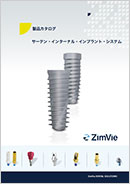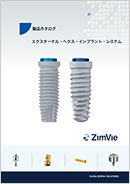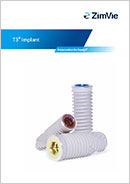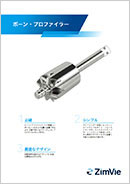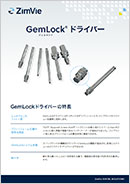T3インプラントはティッシュ・プリザベーション(組織温存)による審美性の獲得を目的にデザインされています。
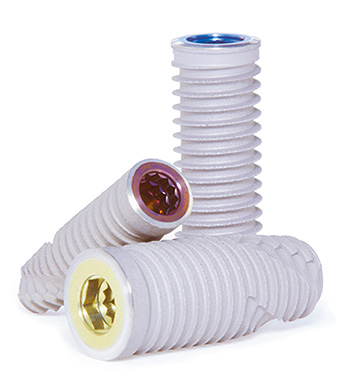
T3ハイブリッド・サーフェイス
複合的に微細加工された表面性状
インプラント/アバットメント間の高い密閉性
耐久性・密閉性に優れたコネクションシステム
プラットフォーム・スイッチング
インプラント/アバットメント接合部をインプラント径よりも内側に移動
審美性の阻害要因
|
オッセオインテグレーション |
インプラント周囲炎 | 歯槽骨頂部の吸収 | ||
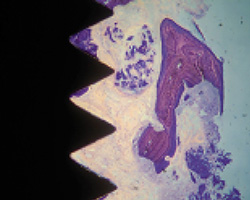 |
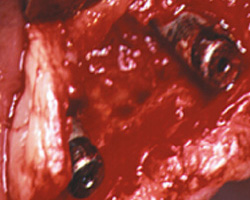 |
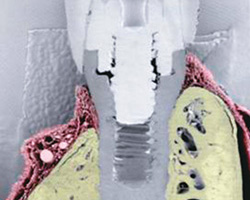 |
||
| 複雑さを欠くサーフェスやプライマリースタビリティを得られないインプラントは、オッセオインテグレーション獲得までにより多くの時間を要する。1,2 | インプラント周囲炎の有病率は12%を超えるとの報告がある。3,4 | 術後1年経過時のインプラント周囲の平均的な骨吸収は1.5mmを超えることがあり、審美性を損なう要因となる。5 |
T3 ハイブリッド・サーフェイス
インプラントのスレッド部はマクロ、ミクロレベルで加工された複雑な表面性状(1.4μm:SA値)を実現。14
SA値:インプラント表面全体の粗さを示した3D解析平均値
|
インプラントカラー部:
ミクロレベル:1-3μm 長期臨床実績のあるオッセオタイト表面性状と同様のダブル酸処理されたカラー部
|
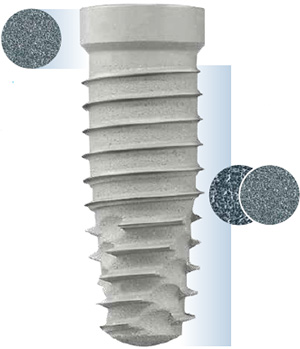 |
インプラント・スレッド部:
マクロレベル:10+μm リン酸カルシウム顆粒でブラスト処理されたラフサーフェイス
ミクロレベル:1-3μm ブラスト処理された表面上をダブル酸処理することで、より複雑な表面へ
|
T3® DCD® サーフェイス
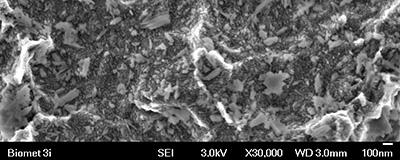
インプラント全長に施されたDCD®(Discrete Crystalline Deposition)処理によるナノレベルの表面性状
DCD®(Discrete Crystalline Deposition)
ブラスト処理 + ダブル酸処理された表面上にナノレベルのHA結晶を溶着させることで、更に微細で複雑な表面を実現 (写真: 10-100nmのHA結晶 ×30,000)
T3® ハイブリッド・サーフェイス・インプラント
プライマリー・スタビリティ 6,7,8
インプラント埋入直後に骨-インプラント間(Bone-to-Implant Contact)の接触率を高めることは、初期安定性を得るための重要な要素である。9 専用外科器具で形成されたインプラント窩はT3インプラント形状と相似し、骨-インプラント間の接触率を高めることで初期安定性が期待できる。
オッセオインテグレーション 10,11
前臨床試験において*、T3 DCDインプラントサーフェイスは、従来型の表面性状に比べ治癒段階を通じて高い骨結合力を示した。11
インプラント周囲炎リスクの軽減 12,13
T3インプラントのカラー部には長期臨床実績のあるオッセオタイト表面性状を採用。5年追跡の臨床研究**によれば、全長にダブル酸処理を施したオッセオタイトインプラントはカラー部を機械研磨したハイブリッドインプラントと比較して、インプラント周囲炎、軟組織の合併症発生リスクの上昇を示すことはなかった。12
オッセオタイト・インプラント(全体をダブル酸処理)と
ハイブリッド・インプラント(カラー部:機械研磨、ボディ部:ダブル酸処理)の
インプラント周囲炎に関する多施設間、5年追跡ランダム化比較試験**
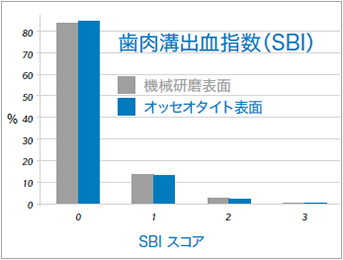 |
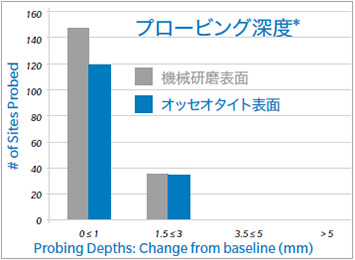 |
|
| SBIスコア”0”(出血無し)は84%、スコア”1”は13%(稀に出血がみられる)であった | どちらのインプラントにおいても、ベースラインから3.0mm以上のプロービング深度の変化はなかった |
112人の患者に、139本の対照インプラント、165本の試験インプラントを埋入した(計304本)。
* 前臨床試験は必ずしも臨床成績を示すものではない
** Zetterqvist et al. A Prospective, Multicenter, Randomized Controlled 5-Year Study Of Hybrid And Fully Etched Implants For The Incidence Of Periimplantitis. J Periodontol April 2010.
インプラント/アバットメント間の高い密閉性
インプラント/アバットメント間の高い密閉性によりマイクロムーブメントを最小化し、潜在的な微小漏洩を軽減。
インプラント/アバットメント間の密閉強度
精緻に設計、加工されたコネクション部と最大化された締結力により微小漏洩を軽減。
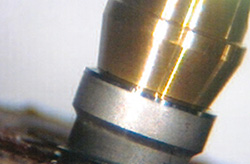
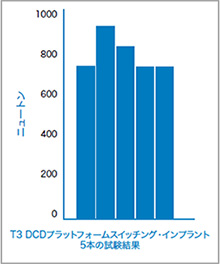
インプラント/アバットメント密閉強度試験
動的流体漏洩試験(割れ目からの漏洩)
2011年7月から2012年6月にかけて、バイオメット3i 社はインプラント/アバットメントコネクションシステムの評価を目的とする動的疲労漏洩試験を実施。試験の設定条件は、ISO14801の歯科用骨内インプラントの動的疲労試験を適用
・ベンチ試験の結果は、必ずしも臨床成績を示すものではない
・弊社試験データ
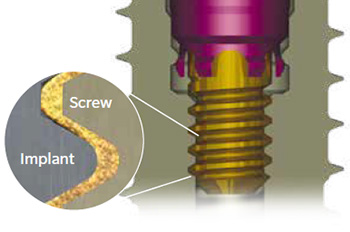
インプラント/アバットメント間の締結力
ゴールドタイト・スクリューを用いることで、非ゴールドコーティングスクリューと比較して113%まで締結力が向上。( サーテン・インターナルコネクション)15
ゴールドタイト・スクリューのゴールドコーティングがシーリング材となり締結力を増大させることで、アバットメントの安定性を最大化。16
プラットフォーム・スイッチング
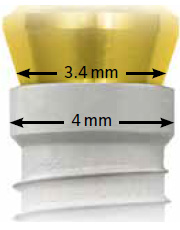
プラットフォーム・スイッチングによるリモデリング
インプラント/アバットメント接合部をインプラントのプラットフォーム径の内側に移動させることで、生物学的幅径を確立し歯槽骨頂部の温存が期待できる。17
歯槽骨頂部の温存
研究では、プラットフォーム・スイッチングされたインプラントの使用により歯槽骨頂の喪失は僅か0.37mmであった。*18
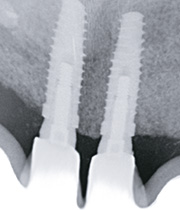
ノンプラットフォーム・スイッチングとの比較 19
インプラントプラットフォーム径の内側に移動されたインプラント/アバットメント接合様式により周囲組織を支え、組織退縮を50%軽減.*
* 必ずしも全ての被験者に対しての典型的、特徴的あるいは代表的な結果ではない。
サーテン・インターナル・インプラント
D=直径/P=プラットフォーム径、*=受注発注品
テーパード
T3 プラットフォームスイッチング・インプラント
 |
|
||||||||||||||||||||||||||||||||||||||||||||||||
T3 インプラント
 |
|
||||||||||||||||||||||||||||||||||||||||||||||||||||||||||||||
パラレルウォールド
T3 プラットフォームスイッチング・インプラント
 |
|
||||||||||||||||||||||||||||||||||||||||||||||||
T3 インプラント
 |
|
||||||||||||||||||||||||||||||||||||||||||||||||||||||||||||||
承認番号 22500BZX00234000、22600BZX00290000
エクスターナル・ヘクス・インプラント
D=直径/P=プラットフォーム径、*=受注発注品
テーパード
T3 テーパードインプラント
 |
|
||||||||||||||||||||||||||||||||||||||||||||||||||||||||||||||
パラレルウォールド
T3 パラレルウォールド・インプラント
 |
|
|||||||||||||||||||||||||||||||||||||||||||||||||||||||||||||||||||||||||||||||||||||||
承認番号 22600BZX00131000、22600BZX00470000
製品資料ダウンロード
参考文献
01. Sullivan DY, Sherwood RL, Porter SS. Long-term performance of Osseotite® Implants: A 6-year follow-up Compendium. 2001 Apr;Vol.22, No.4.
02. Javed F, Romanos GE. The role of primary stability for successful immediate loading of dental implants. A literature review. J Dent. 2010 Aug;38(8):612-20. Epub 2010 Jun 11. Review.
03. Fransson C, Lekholm U, Jemt T, Berglundh T. Prevalence of subjects with progressive bone loss at implants. Clinical Oral Implants Research. 2005;16:440–446.
04. Zitzmann NU, Berglundh T. Definition and prevalence of peri-implant diseases. J Clin Perio. 2008;35:286–291.
05. Lazzara RJ,† Porter SS. Platform Switching: A new concept in implant dentistry for controlling post restorative crestal bone levels. Int J Periodontics Restorative Dent. 2006;26:9-17.
06. Östman PO†, Wennerberg A, Ekestubbe A, et al. Immediate occlusal loading of NanoTite™ tapered implants: A prospective 1-year clinical and radiographic study. Clin Implant Dent Relat Res. 2012 Jan 17.
07. Block MS†. Placement of implants into fresh molar sites: Results of 35 cases. J Oral Maxillofac Surg. 2011 Jan;69(1):170-174.
08. Meltzer AM†. Immediate implant placement and restoration in infected sites. Int J Periodontics Restorative Dent. 2012 Oct;32(5):e169-173.
09. Meredith N. Assessment of implant stability as a prognostic determinant. Int J Prosthodont. 1998 Sep-Oct;11(5):491-501.
10. Nevins M†, Nevins ML, Schupbach P, Fiorellini J, Lin Z, Kim DM. The impact of bone compression on bone-to-implant contact of an osseointegrated implant: A canine study. Int J Periodontics Restorative Dent. 2012 Dec;32(6):637-645.
11. Mendes V, Davies JE. Early Implant healing at implant surfaces of varying topographical complexity. Poster Presentation: Academy of Osseointegration, 26th Annual Meeting; March 2011; Washington, DC.
12. Zetterqvist L, Feldman S, Rotter B, et al. A prospective, multicenter, randomized-controlled 5-year study of hybrid and fully etched implants for the incidence of peri-implantitis. J Periodontol. 2010 April;81:493-501.
13. Lang NP, Berglundh T. Periimplant diseases: Where are we now?-Consensus of the Seventh European Workshop on Periodontology; Working Group 4 of Seventh European Workshop on Periodontology. J Clin Perio. 2011 Mar;38 Suppl 11:178-181.
14. Gubbi P††, Towse R††, Quantitative and qualitative characterization of various dental implant surfaces. Poster Presentation P421: European Association For Osseointegration, 20th Meeting; October 2012; Copenhagen, Denmark.
15. Suttin Z††, Towse R††. Effect of abutment screw design on implant system seal performance. Presented at the European Association for Osseointegration, 20th Annual Scientific Meeting; October 2012; Copenhagen, Denmark.
16. Byrne D, Jacobs S, O’Connell B, Houston F, Claffey N. Preloads generated with repeated tightening in three types of screws used in dental implant assemblies. J. Prosthodont. 2006 May–Jun;15(3):164-171.
17. Lazzara RJ, Porter SS. Platform switching: A new concept in implant dentistry for controlling postrestorative crestal bone levels. Int J Perio Rest Dent. 2006;26:9-17.
18. Östman PO,† Wennerberg A, Albrektsson T. Immediate occlusal loading of NanoTite prevail implants: A prospective 1-year clinical and radiographic study. Clin Implant Dent Relat Res. 2010 Mar;12(1):39-47.
19. Boitel N, Andreoni C, Grunder U†, Naef R, Meyenberg K†. A three year prospective, multicenter, randomized-controlled study evaluating platform-switching for the preservation of peri-implant bone levels. Poster Presentation P83: Academy of Osseointegration, 26th Annual Meeting: 2011 March 3-5; Washington DC.
† Dr. Block, Dr. Goené, Dr. Grunder, Dr. Lazzara, Dr. Makigusa, Dr. Meltzer, Dr. Méndez, Dr. Meyenberg, Dr. Nevins, Dr. Östman, Dr. Rodríguez, Dr. Segalá, Dr. Scutellá, Dr. Tarnow, Dr. Testori and Dr. Vela have financial relationships with Biomet 3i,LLC resulting from speaking engagements, consulting engagements and other retained services.
†† Dr. Gubbi, Mr. Suttin and Mr. Towse contributed to the above research while employed by Biomet 3i.
References 6–10 discuss the Tapered Implant macrodesign, which is incorporated into the T3 Implant. References 10–13 discuss the Osseotite and/or NanoTite Implants’ dual acid-etched or DCD technology, which is incorporated into the T3 Implant. References 20–22 discuss PREVAIL® Implants with an integrated platform switching design, which is also incorporated into the T3 Implant.

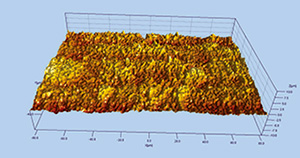 SA値:0.5μm
SA値:0.5μm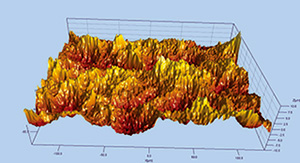 SA値:1.4μm
SA値:1.4μm